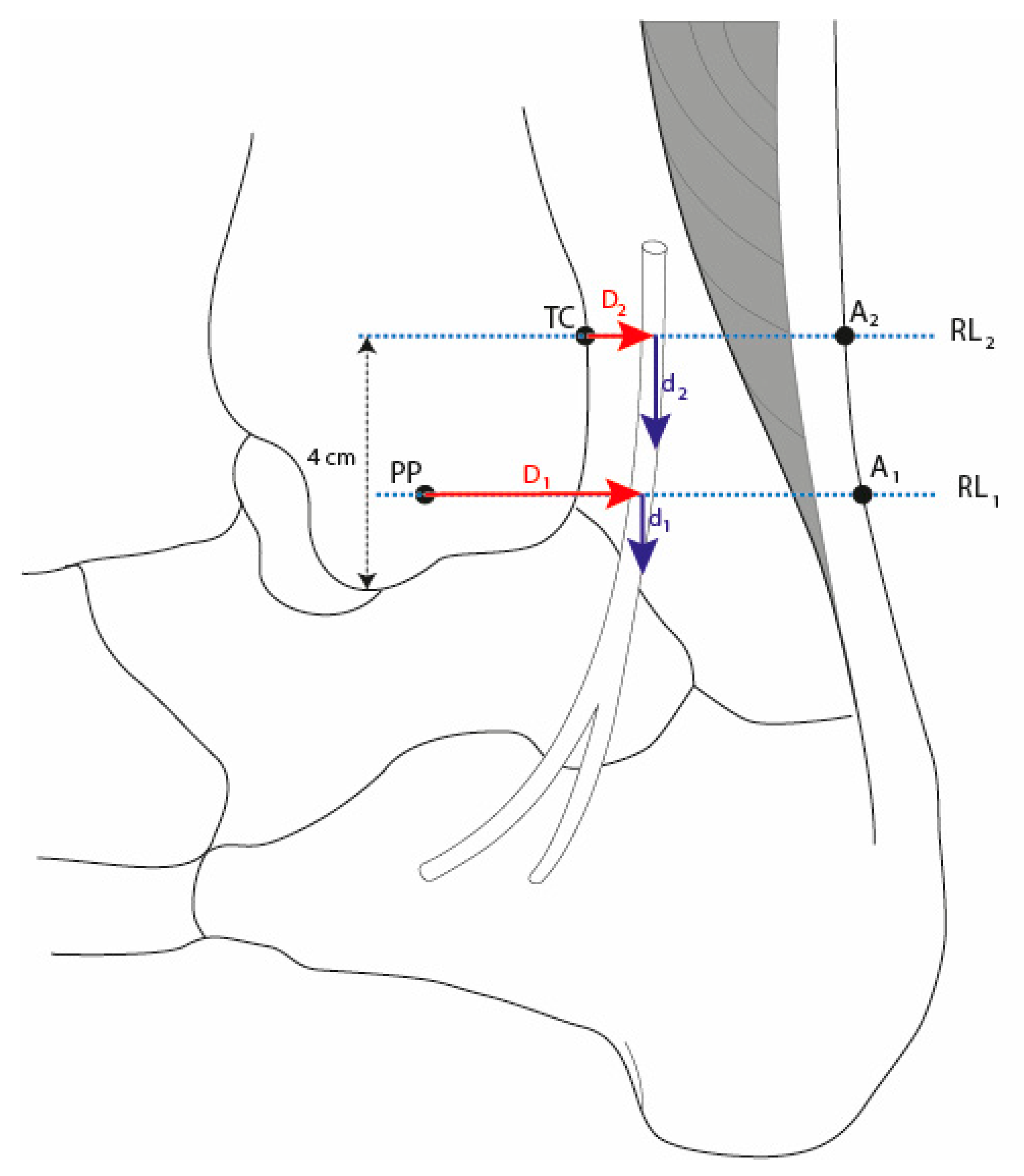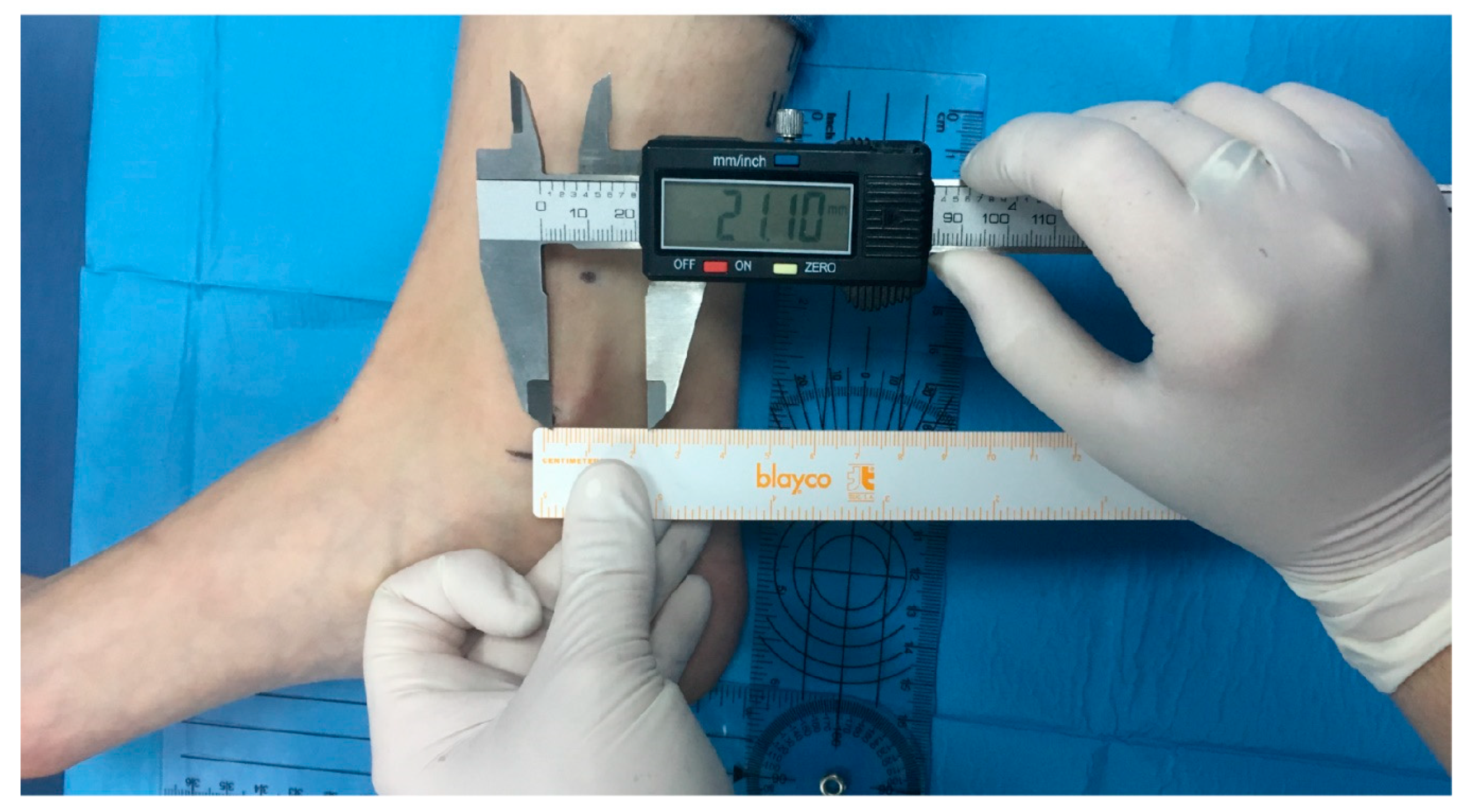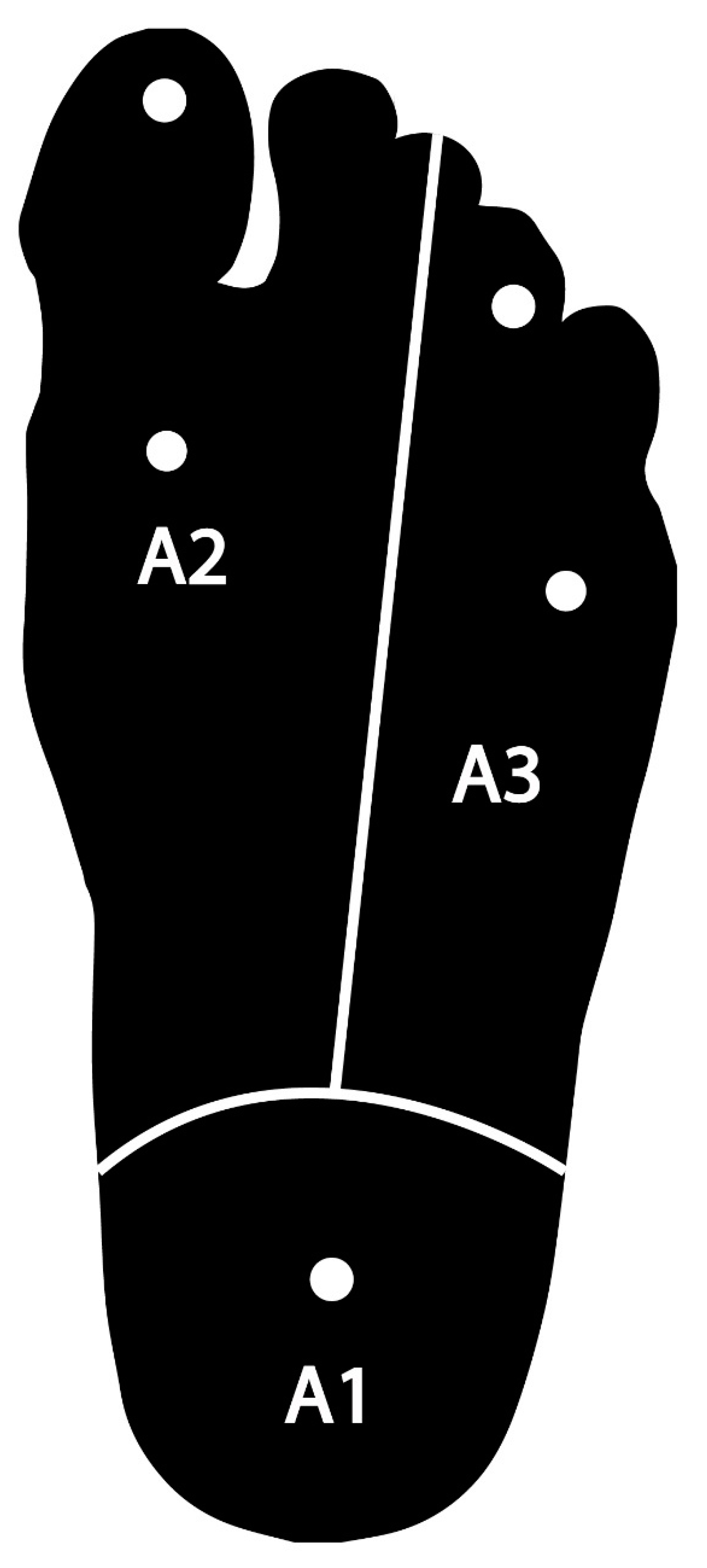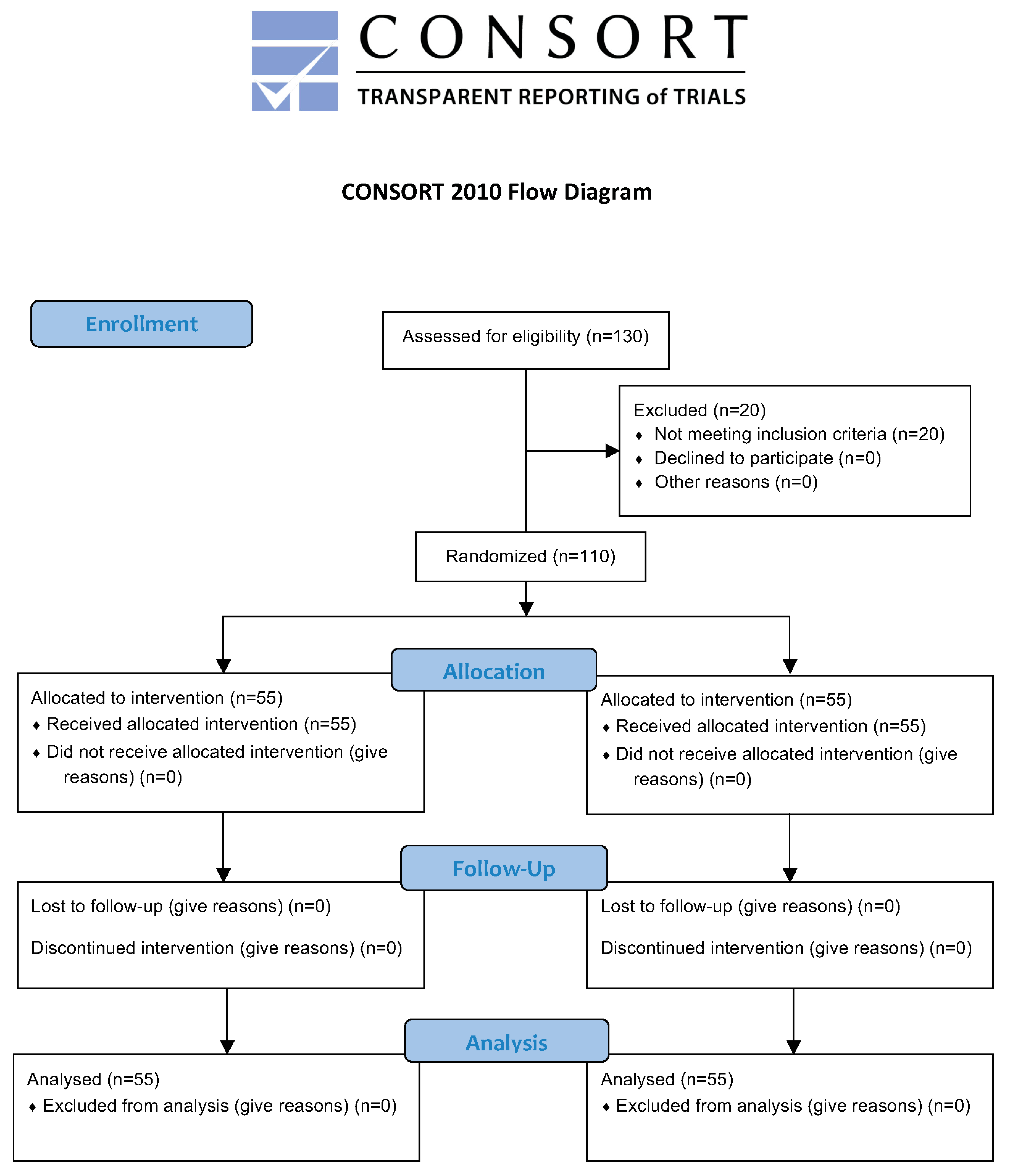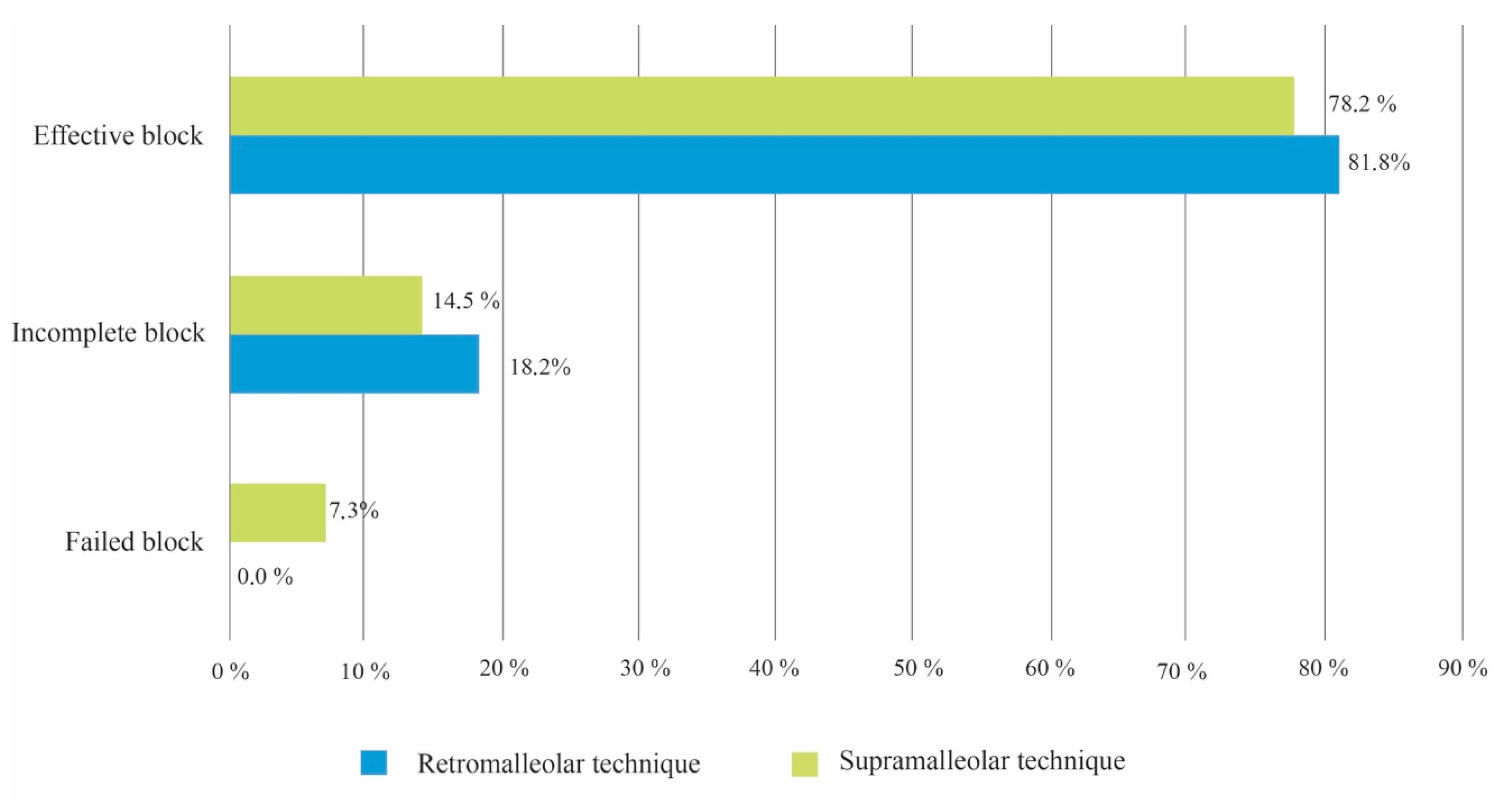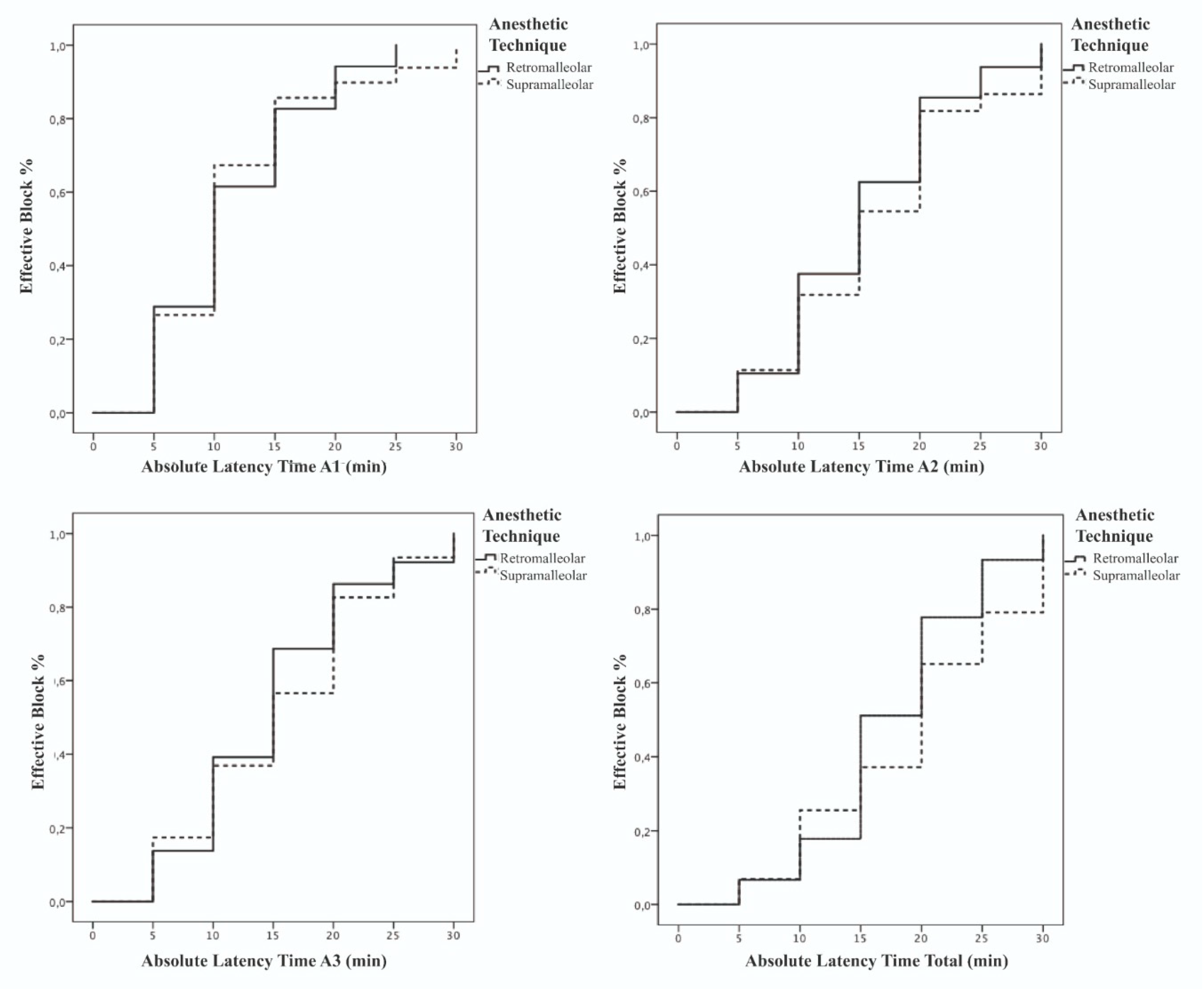1. Introduction
Ankle blocking is a safe technique associated with a high success rate and a low risk of complications, and is very well accepted by both surgeons and patients [
1]. Its main advantage compared with a combined femoral and sciatic nerve block is that there is no motor blocking above the ankle. This facilitates rapid mobilization of the patient, which is a relevant consideration in outpatient surgery, particularly in cases that require bilateral anesthetic procedures [
2].
Of the five nerves that innervate the foot, the one in which anesthetic blocking presents the greatest difficulty is the tibial nerve. Several studies have agreed in locating the bifurcation of the tibial nerve at the tarsal tunnel level in a great number of cases [
3,
4,
5,
6]. However, a number of publications [
3,
7,
8,
9] note that the branching point of the calcaneal nerve shows considerable anatomical variation between individuals, which can contribute to a high rate of incomplete or failed blocks.
The particular interest in effective blocking of the tibial nerve is because a successful ankle block almost always depends on achieving satisfactory anesthetic blocking of this nerve. Moreover, in the majority of incomplete ankle block cases, the sensitivity is located in the region innervated by the tibial nerve [
10,
11,
12].
The classic ankle block technique blocks the tibial nerve at the level of the upper edge of the medial malleolus [
13,
14,
15]. The needle is placed behind the posterior tibial artery. However, the arterial pulse is not identified properly in many occasions. This considerably increases the difficulty for blocking tibial nerve, especially in the case of patients with edematous feet or peripheral vascular disorders. Furthermore, effective blocking of the tibial nerve necessitates blocking all three of its terminal branches: the calcaneal nerve, the medial plantar nerve, and the lateral plantar nerve. The first author to suggest a more proximal approach to the tibial nerve to ensure blocking of its three terminal branches was Gerbert in 1971 [
16]. This author only suggested moving the injection site and gave no information on the success of the technique.
The objective of the present trial was to establish a protocol for two new tibial nerve block anesthetic techniques, to later compare the anesthetic efficiency of a retromalleolar tibial nerve block at the level of the most prominent point of the medial malleolus to that of a supramalleolar tibial nerve block injected 4 cm proximally from the lower edge of the medial malleolus, comparing as well the ease or difficulty of execution of each of the technique. Neither technique was based on the location of the posterior tibial artery pulse. The study hypothesis was that a supramalleolar tibial nerve block using a conventional technique could achieve a higher effective blocking rate, as the tibial nerve is less likely to have divided into its terminal branches.
2. Materials and Methods
2.1. Subjects
The study population was composed of surgical patients of the University of Valencia podiatric clinic (
n = 133). In a single-blinded randomized controlled trial to ascertain and compare the anesthetic efficiency of supramalleolar and retromalleolar tibial nerve blocking, a total of 110 patients scheduled for foot surgery that required tibial nerve blocking were assigned at random to one of the two groups. Consort statement was followed for reporting parallel group randomized trials (see
Table S1 in supplementary materials). The bases and conditions of this clinical trial were authorized by the Research in Humans Ethics Committee of the Experimental Research Ethics Commission of the University of Valencia (Spain) under procedure number H1477566491165. This clinical trial was registered with the ISRCTN registry (International Standard Randomised Controlled Trial Number) under number ISRCTN12176047. All the participants gave their written informed consent to participating voluntarily in the study.
To select the study sample, the following inclusion criteria were defined: subjects of both sexes, between 18 and 75 years of age, classified in the ASA Physical Status Classification System as ASA I (normal healthy patient) or ASA II (patient with a mild systemic disease that is well-controlled and with no functional limitations; for example, treated hyperthension), and requiring anesthetic blocking of the tibial nerve. Subjects with non-palpable peripheral pulses and/or an ankle edema that made it impossible to locate the anatomical reference points were excluded. Other exclusion criteria were coagulation disorders and/or infections at the target injection sites, a record of allergies to amide type local anesthetics, pregnancy or lactation, neurological or neuromuscular diseases, chronic analgesic treatment with opiate derivatives, and cognitive impairment.
A simple randomized list (allocation sequence) with numeric sequential unique identifiers was produced by software (Random Allocation Software 1.0 by Mahmood Saghaei from Isfahan University, Iran) for a sample size of 110 patients divided into two groups of equal sizes (allocation ratio 1:1). There were no restrictions such as blocking or block size. In this way, the participants were divided at random into two groups, which received either a supramalleolar tibial nerve block (SMB group, n = 55) or a retromalleolar tibial nerve block (RMB group, n = 55). The name of the group was placed in a sealed opaque envelope and the sequential numbers assigned to it were written on the front of the envelope. As the patients agreed to participate in the study, the auxiliary staff assigned them to the intervention groups, following the sequence.
2.2. Establishing Protocol of the Anesthetic Techniques under Study: Definition of the Injection Site Coordinates
The reference point for the retromalleolar technique was the most prominent point of the medial malleolus. The supramalleolar technique was performed 4 cm proximally from the lower edge of the medial malleolus (
Figure 1). The injection coordinates (distance, needle depth, and needle angle) were obtained from prior ultrasound scans of the tibial nerve of 100 subjects in order to locate the anatomical position of the tibial nerve at the retromalleolar and supramalleolar levels based on the sex and the height of the subjects. These scans provided the anatomical coordinates for optimum identification of the injection site for tibial nerve blocking (
Table 1). The distance coordinates for both techniques were calculated on straight lines between the respective bony reference points and the Achilles tendon, using a conventional 15 cm ruler. The exact injection site (distance from the reference point) was measured with a digital caliper with 0.1 mm accuracy (
Figure 2). The needle insertion depth was marked with a sterile surgical marker. The angle of the needle was determined by the position of the tibial nerve within the vascular and nerve bundle (anterior, posterior, or lateral to the posterior tibial artery).
2.3. Experimental Procedure
For both techniques, anesthetic blocking of the tibial nerve was performed with the subject’s foot at a 90° angle to the tibia, using a goniometer for this purpose. A 23G 0.60 × 25 mL BL/L Braun® needle and a conventional 5 mL syringe were used. The anesthetic solution administered was 3 mL of 2% mepivacaine without a vasoconstrictor (Scandinibsa®). Preanesthetic medication was not prescribed for any of the subjects.
The primary outcome was the success rates achieved with the retromalleolar and supramalleolar techniques. This was determined by the anesthetic result (blocking effective, incomplete, or failed). The anesthetic result was measured by the extent of blocking, in other words, the number of areas with an absence of pain sensitivity and thermal sensitivity. For this purpose, the tibial nerve dermatome was divided into three areas (
Figure 3). A1 was the region innervated by the calcaneal nerve, A2 was the region innervated by the medial plantar nerve, and A3 was the region innervated by the lateral plantar nerve. Absence of pain sensitivity was evaluated by pin-prick test with 21G needle. Absence of thermal sensitivity was evaluated by swab soaked in alcohol. Both sensitivity tests were conducted at five-minute intervals, starting five minutes after injection of the local anesthetic and ending on reaching the absolute latency time or 30 min after the blocking injection.
The tibial nerve blocking result, measured 30 min after initiating the block, was considered a failed block if the patient presented pain in the pin-prick test or sensitivity to cold in each of the three areas into which the tibial nerve dermatome was divided; an incomplete block if the patient only felt pain or cold in one or two of the areas; or an effective block if pain on pin-pricking and sensation of coldness were absent from all three areas.
In the incomplete or failed tibial nerve block cases, high-volume distal infiltration of a second tibial nerve block was administered prior to commencing surgery (7 mL of 2% mepivacaine, distal to the lower edge of the medial malleolus).
As secondary outcomes, the following were recorded: vascular puncture (positive aspiration), peri/intraneural puncture (electric shock sensations during puncture), the relative latency time (time in seconds from inserting the needle until the patient showed the first symptoms of anesthesia), the absolute latency time (time in seconds between inserting the needle and a complete absence of pain and thermal sensitivity in the sole of the foot), anesthetic blocking duration (time in hours between attaining blocking and the first appearance of paresthesias in the sole of the foot), the patient’s level of pain during puncture, and the need for intraoperative anesthetic reinforcement. The subject’s pain level during puncture was assessed on a 10-point visual analog scale (VAS) [
17]. VAS scores of 0–3 were considered low pain, 4–6 moderate pain, and 7–10 intense pain. The need for intraoperative anesthetic reinforcement was measured by the number of patients who had attained effective blocking of the tibial nerve, but required additional local anesthetic during surgery.
All the anesthetic blocks were administered by the same person, the principal researcher in this study. The variables were analyzed and tested by an external observer who did not know which type of anesthetic block the subject had received and who was trained in evaluating and recording the findings as they were obtained.
2.4. Statistical Analysis
To calculate the sample size, the success rate of a conventional ankle blocking technique was assumed to be 66% in the reference population, as described recently by Chin et al. [
18]. The present trial was expected to attain success rates of 66% for the retromalleolar technique and 90% for the supramalleolar technique. On this assumption, the necessary sample sizes were estimated as 44 patients in each of the two groups, accepting an alpha risk of 0.05 and a beta risk of 0.2 in a bilateral contrast. The expected loss to follow-up was 0%.
The data obtained were analyzed with IBM SPSSv22 software (Chicago, IL, USA). Means and the 95% confidence intervals (95% CI) were determined for the quantitative variables and percentages for the categorical variables. Student’s t-test was used to compare means. The equality of variances for the choice of the p-value of the Student’s t-test was valued by the Levene test. The Chi-squared test was used to compare percentages. A Kaplan–Meier survival analysis was performed with the log rank (Mantel–Cox), Breslow, and Tarone–Ware tests to explore the variables expressed as events over time. For all these tests, the significance level was set at p < 0.05.
3. Results
All the participants randomly assigned to the two study groups (SMB and RMB) completed the trial (
Figure 4). Their distribution by sex was 35 women (63.6%) and 20 men (36.4%) in the RMB group (retromalleolar technique) and 34 women (61.8%) and 21 men (38.2%) in the SMB group (supramalleolar technique).
Table 2 shows a comparison of the sample characteristics for the two study groups (RMB and SMB).
Table 3 shows comparisons of anesthesia times and levels of pain registered during the two anesthetic procedures. Student’s
t-test found no statistically significant difference for any of the variables analyzed.
Table 4 shows a comparison of the anesthetic results achieved with the two techniques. The Chi-squared test found no statistically significant difference in the success rates of the two procedures (
p = 0.634) (
Figure 5). Nor were significant differences between the two techniques found for vascular puncture percentage (Chi-squared test
p = 0.507) or for peri-/intraneural puncture percentage (Chi-squared test
p = 0.751).
Figure 6 shows the percentage of effective blocks based on the latency time for each of the areas and anesthetic techniques, after carrying out the Kaplan–Meier analysis. The Mantel–Cox Log Rank (
p = 0.114), Breslow (
p = 0.271), and Tarone–Ware (
p = 0.183) tests showed no statistically significant differences between the survival curves of the retromalleolar technique and the supramalleolar technique in any of the three areas into which the tibial nerve dermatome was divided.
4. Discussion
The initial hypothesis in the present trial was that blocking the tibial nerve at the supramalleolar level could achieve a higher rate of effective blocks, in that the nerve might be less likely to have forked into its terminal branches at that point. However, the trial results show not statistically significant differences between the two techniques.
The reason for the lack of statistical difference could be owing to the prior protocol that has been established for the two techniques. The injection site coordinates used in both techniques under study were based on a prior ultrasound study of the tibial nerve in a population of 100 subjects, which determined both the mean distance between the nerve and the osseous reference point and the depth of the nerve beneath the skin surface without directly touching the vascular and nerve bundle. In other words, ultrasound was used to determine, prior to performing the techniques, the injection site coordinates, not to perform echo-guided tibial nerve blocks. The purpose was to improve the efficiency of blocks administered by a conventional technique without instrumentation, that is, without the need for an ultrasound scanner. This would not only provide an economical advantage for the professional, but it would also increase the speed at which this anesthetic technique can be performed, as well as a reduction in the lacerations of the tissues caused by redirection of the needle.
The most prominent point of the medial malleolus was chosen as the reference point for the retromalleolar technique because it is an osseous prominence, which is easily recognized regardless of the anatomical characteristics of the subject’s ankle. The decision to block the nerve 4 cm proximally from the lower edge of the medial malleolus in the supramalleolar technique was based on the ultrasound image of the tibial nerve. A more proximal location of the nerve would have hindered correct ultrasound identification of the structure corresponding to the tibial nerve and, consequently, the definition of the target coordinates for the supramalleolar injection.
In the case of the retromalleolar anesthetic, no failed tibial nerve block was obtained. The same cannot be said of the supramalleolar technique, for which four failed blocks were recorded. These results highlight the greater difficulty in locating the tibial nerve at the supramalleolar level. A study by Larrabure et al. [
19] also highlights the difficulty in locating the tibial nerve in a more proximal anatomical position. The tibial nerve dermatoma area that presented the greatest difficulty in achieving thermal and pain sensitivity blocking, with both the retromalleolar and the supramalleolar technique, was that of the medial plantar nerve. These results differ from those obtained by Hromádka et al. [
10]. In their study, incomplete blocking of the tibial nerve was located in the lateral plantar nerve area.
As regards to anesthetic blocking of the calcaneus nerve dermatome (A1), the percentage of effective block achieved at the supramalleolar approach (89.1%) could corroborate a suggestion by some authors that the tibial nerve forks even more proximally than 4 cm above the lower edge of the medial malleolus [
4,
8,
16,
20].
Both of the tibial nerve blocking techniques used in the present trial were characterized by a single injection with no change in needle direction, a minimum effective volume of local anesthetic (3 mL), and an effective anesthetic verification time-out, in keeping with the onset of action time described for the anesthetic administered. The volume of anesthetic could explain why the retromalleolar and supramalleolar techniques under study obtained lower success rates than those reported by other authors based on high volume bloking [
10,
14,
15,
21] (
Table 5). Specifically, with the minimum volume administered, the tibial nerve block success rate was 81.8% for the retromalleolar technique and 78.2% for the supramalleolar technique, although without significant differences between the two techniques. None of the subjects in whom the retromalleolar or supramalleolar technique achieved an effective tibial nerve block required intraoperative anesthetic reinforcement owing to insufficient analgesia. The mean blocking duration for both the retromalleolar technique and the supramalleolar technique guaranteed an adequate period of analgesia for any foot surgery procedure. Both study groups rated the pain perceived during the anesthetic process as low on the VAS.
Although the retromalleolar and supramalleolar techniques described in the present trial did not achieve 100% success rates, they did register a considerably higher number of effective blocks than those described for other conventional techniques [
13,
18], which are not based on a high volume tibial nerve block (22% and 66% of success rates reported, respectively). Indeed, the success rate with the retromalleolar technique was greater than that reported (72%) for the ultrasound-guided technique [
13].
Future lines of research aim to investigate further the topographical anatomy of the tibial nerve and its relation to the posterior tibial artery in the ankle region. Determining if the foot type (rectus, planus, or cavus) influences the position of the tibial nerve could assist in adjusting the needle angle and puncture procedures and, if possible, further standardizing the needle insertion target points for tibial nerve blocking using a conventional technique without instrumentation. Authors also aim to establish an anesthetic technique for sural nerve block protocol to later compare the anesthetic efficiency obtained with that of the conventional technique described in the literature.
5. Conclusions
The two anesthetic techniques under study provided very similar clinical results. Contrary to the initial expectations, the supramalleolar approach did not achieve a higher effective blocking rate. The reason for the lack of statistical difference could be owing to the prior protocol that has been established for the two techniques. The injection coordinates (distance, needle depth, and needle angle) were obtained from prior ultrasound scans in order to locate the anatomical position of the tibial nerve at the retromalleolar and supramalleolar levels based on the sex and the height of the subjects. These scans provided the anatomical coordinates for optimum identification of the injection site for tibial nerve blocking.
Both anesthetic techniques were well accepted by the subjects and registered a considerably higher number of effective blocks than those that are not based on a high volume tibial nerve block. Both anatomic-landmark techniques were characterized by a single injection with no change in needle direction and a minimum effective volume of local anesthetic.
The greater ease in locating the tibial nerve in the retromalleolar approach could suggest that this is the technique of choice for tibial nerve blocking, especially in the case of professionals new to the field. Supramalleolar technique could be worth considering for those more experienced professionals and, particularly, in patients with restricted retromalleolar area access, owing, for example, to disorders or distortion of the ankle anatomy. In these cases, it would be recommended to perform echo-guided tibial nerve blocks to ascertain the anatomical position of the nerve with greater accuracy.
Author Contributions
Conceptualization, M.B.-F. and C.M.-R.; methodology, M.B.-F., R.C., and C.M.-R.; validation, J.M.A.-S.; formal analysis, J.M.M.-C.; investigation, M.B.-F.; resources, C.M.-R. and J.M.A.-S.; data curation, J.M.M.-C.; writing—original draft preparation, M.B.-F.; writing—review and editing, M.B.-F., J.M.M.-C., J.M.A.-S., R.C., and C.M.-R.; visualization, J.M.M.-S.; supervision, J.M.A.-S and C.M.-R.; project administration, M.B.-F. All authors have read and agreed to the published version of the manuscript.
Funding
This research received no external funding.
Acknowledgments
The authors are grateful to all the participants in this trial. They also wish to thank Mary Georgina Hardinge and Empar Vengut for translating the manuscript into English.
Conflicts of Interest
The authors declare no conflict of interest.
References
- Tryba, M. Ankle Block: A Safe and Simple Technique for Foot Surgery. Curr. Opin. Anaesthesiol. 1997, 10, 361–365. [Google Scholar] [CrossRef]
- Fredrickson, M.J. Ultrasound-Guided Ankle Block. Anaesth. Intensive Care 2009, 37, 143–144. [Google Scholar] [PubMed]
- Andreasen Struijk, L.N.S.; Birn, H.; Teglbjærg, P.S.; Haase, J.; Struijk, J.J. Size and Separability of the Calcaneal and the Medial and Lateral Plantar Nerves in the Distal Tibial Nerve. Anat. Sci. Int. 2010, 85, 13–22. [Google Scholar] [CrossRef] [PubMed]
- Dellon, A.L.; Mackinnon, S.E. Tibial Nerve Branching in the Tarsal Tunnel. Arch. Neurol. 1984, 41, 645. [Google Scholar] [CrossRef] [PubMed]
- Davis, T.J.; Schon, L.C. Branches of the Tibial Nerve: Anatomic Variations. Foot Ankle Int. 1995, 16, 21–29. [Google Scholar] [CrossRef]
- Horwitz, M.T. Normal Anatomy and Variations of the Peripheral Nerves of the Leg and Foot. Arch. Surg. 1938, 36, 626–636. [Google Scholar] [CrossRef]
- Govsa, F.; Bilge, O.; Ozer, M.A. Variations in the Origin of the Medial and Inferior Calcaneal Nerves. Arch. Orthop. Trauma Surg. 2006, 126, 6–14. [Google Scholar] [CrossRef]
- Kim, B.S.; Choung, P.W.; Kwon, S.W.; Rhyu, I.J.; Kim, D.H. Branching Patterns of Medial and Inferior Calcaneal Nerves Around the Tarsal Tunnel. Ann. Rehabil. Med. 2015, 39, 52–55. [Google Scholar] [CrossRef]
- Havel, P.E.; Ebraheim, N.A.; Clark, S.E.; Jackson, W.T.; DiDio, L. Tibial Nerve Branching in the Tarsal Tunnel. Foot Ankle 1988, 9, 117. [Google Scholar] [CrossRef]
- Hromádka, R.; Barták, V.; Popelka, S.; Pokorný, D.; Jahoda, D.; Sosna, A. Ankle Block Implemented through Two Skin Punctures. Foot Ankle Int. 2010, 31, 619–623. [Google Scholar] [CrossRef]
- WASSEF, M.R. Posterior Tibial Nerve Block. Anaesthesia 1991, 46, 841–844. [Google Scholar] [CrossRef] [PubMed]
- Delgado-Martínez, A.D.; Marchal, J.M.; Molina, M.; Palma, A. Forefoot Surgery with Ankle Tourniquet: Complete or Selective Ankle Block? Reg. Anesth. Pain Med. 2001, 26, 184–186. [Google Scholar] [CrossRef] [PubMed]
- Redborg, K.E.; Antonakakis, J.G.; Beach, M.L.; Chinn, C.D.; Sites, B.D. Ultrasound Improves the Success Rate of a Tibial Nerve Block at the Ankle. Reg. Anesth. Pain Med. 2009, 34, 256–260. [Google Scholar] [CrossRef] [PubMed]
- Rudkin, G.E.; Rudkin, A.K.; Dracopoulos, G.C. Ankle Block Success Rate: A Prospective Analysis of 1000 Patients. Can. J. Anesth. 2005, 52, 209–210. [Google Scholar] [CrossRef]
- Sarrafian, S.K.; Ibrahim, I.N.; Breihan, J.H. Ankle-Foot Peripheral Nerve Block for Mid and Forefoot Surgery. Foot Ankle 1983, 4, 86–90. [Google Scholar] [CrossRef]
- Gerbert, J. The Location of the Terminal Branching of the Posterior Tibial Nerve and Its Effect on Administering a Posterior Tibial Nerve Block. J. Am. Podiatry Assoc. 1971, 61, 8–11. [Google Scholar] [CrossRef]
- Martín, M.A.; Ollé, G.; Pellejero, J.A.; Torruella, R.; Yuste, M.; Pou, N. Comparación de La Eficacia Analgésica Postoperatoria Del Bloqueo de Los Nervios Tibial (a Nivel de Maléolo Interno) y Peroneo Común Con La Infiltración de La Herida Quirúrgica En Cirugía Ambulatoria Del Hallux Valgus. Rev. Esp. Anestesiol. Reanim. 2012, 59, 197–203. [Google Scholar] [CrossRef]
- Chin, K.J.; Wong, N.W.Y.; MacFarlane, A.J.R.; Chan, V.W.S. Ultrasound-Guided versus Anatomic Landmark-Guided Ankle Blocks: A 6-Year Retrospective Review. Reg. Anesth. Pain Med. 2011, 36, 611–618. [Google Scholar] [CrossRef]
- Larrabure, P.; Pandin, P.C.; Vancutsem, N.; Vandesteene, A. Tibial Nerve Block: Evaluation of a Novel Midleg Approach in 241 Patients. Can. J. Anesth. 2005, 52, 276–280. [Google Scholar] [CrossRef]
- Bareither, D.J.; Genau, J.M.; Massaro, J.C. Variation in the Division of the Tibial Nerve: Application to Nerve Blocks. J. Foot Surg. 1990, 29, 581. [Google Scholar]
- Colgrove, R.C. Posterior Tibial Nerve Block. Foot Ankle Int. 2001, 22, 839. [Google Scholar] [CrossRef] [PubMed]
Figure 1.
Diagram of the anatomical reference points for the retromalleolar and supramalleolar technique. PP = most prominent point of the medial malleolus, A1 = projection of a straight line from PP to the rear edge of the Achilles tendon, RL1 = retromalleolar reference line, D1 = distance from PP, TC = medial edge of the tibial cortex 4 cm proximally from the lower edge of the medial malleolus, A2 = projection of a straight line through TC to the rear edge of the Achilles tendon, RL2 = supramalleolar reference line, D2 = distance from TC, d1 = needle depth at retromalleolar approach, d2 = needle depth at supramalleolar approach.
Figure 1.
Diagram of the anatomical reference points for the retromalleolar and supramalleolar technique. PP = most prominent point of the medial malleolus, A1 = projection of a straight line from PP to the rear edge of the Achilles tendon, RL1 = retromalleolar reference line, D1 = distance from PP, TC = medial edge of the tibial cortex 4 cm proximally from the lower edge of the medial malleolus, A2 = projection of a straight line through TC to the rear edge of the Achilles tendon, RL2 = supramalleolar reference line, D2 = distance from TC, d1 = needle depth at retromalleolar approach, d2 = needle depth at supramalleolar approach.
Figure 2.
Retromalleolar injection distance coordinate. Calculation of the target injection site, based on the most prominent point of the medial malleolus, measured with a digital caliper.
Figure 2.
Retromalleolar injection distance coordinate. Calculation of the target injection site, based on the most prominent point of the medial malleolus, measured with a digital caliper.
Figure 3.
Division of the tibial nerve dermatome into three areas. A1 is the area innervated by the calcaneal nerve. A2 is the area innervated by the medial plantar nerve. A3 is the area innervated by the lateral plantar nerve. The circles mark the anatomical zones in which the two types of sensitivity (thermal and pain) were tested.
Figure 3.
Division of the tibial nerve dermatome into three areas. A1 is the area innervated by the calcaneal nerve. A2 is the area innervated by the medial plantar nerve. A3 is the area innervated by the lateral plantar nerve. The circles mark the anatomical zones in which the two types of sensitivity (thermal and pain) were tested.
Figure 4.
Consort flow diagram.
Figure 4.
Consort flow diagram.
Figure 5.
Comparison of the anesthetic results achieved with the two techniques.
Figure 5.
Comparison of the anesthetic results achieved with the two techniques.
Figure 6.
Comparison of the percentage of effective blocks based on the latency time for each of the areas and anesthetic techniques.
Figure 6.
Comparison of the percentage of effective blocks based on the latency time for each of the areas and anesthetic techniques.
Table 1.
Injection site coordinates for both techniques obtained from prior ultrasound scans of the tibial nerve.
Table 1.
Injection site coordinates for both techniques obtained from prior ultrasound scans of the tibial nerve.
| Injection Site Coordinates | Retromalleolar Technique | Supramalleolar Technique |
|---|
| Sex of Subject | Height of Subject (m) | Sex of Subject | Height of Subject (m) |
|---|
| Men | Women | <1.72 | >1.72 | Men | Women | <1.72 | >1.72 |
|---|
| Distance (cm) on a straiht line from the anatomical reference point | 2.28–2.54 | 1.91–2.08 | - | - | 1.80–2.03 | 1.67–1.81 | - | - |
| Vertical distance (cm) from the surface of the skin (needle depht) | 0.9 | 0.9 | - | - | 1.30 | 1.10 | - | - |
| Needle angle (°) | - | - | 90 | 45 | | | 90 | 90 |
Table 2.
Comparison of the sample characteristics for the two study groups (retromalleolar tibial nerve block (RMB) and supramalleolar tibial nerve block (SMB)). CI = confidence interval.
Table 2.
Comparison of the sample characteristics for the two study groups (retromalleolar tibial nerve block (RMB) and supramalleolar tibial nerve block (SMB)). CI = confidence interval.
| Sample Characteristics | Retromalleolar Technique
(n = 55) | Supramalleolar Technique
(n = 55) | Statistical Test |
|---|
| Mean (Range) | 95% CI | Mean (Range) | 95% CI | Student’s t-Test |
|---|
| Age (years) | 36.4 (18–75) | [31.4–41.3] | 36.0 (19–75) | [31.3–40.8] | p = 0.920 |
| Height (m) | 1.66 (1.52–1.86) | [1.64–1.70] | 1.68 (1.50–1.93) | [1.65–1.71] | p = 0.183 |
| Weight (kg) | 63.4 (43–98) | [59.7–67.1] | 64.6 (45–87) | [61.7–67.5] | p = 0.616 |
Table 3.
Comparisons of anesthesia times and levels of pain registered during the two anesthetic procedures. RLT = relative latency time, ALT = absolute latency time, VAS = visual analog scale.
Table 3.
Comparisons of anesthesia times and levels of pain registered during the two anesthetic procedures. RLT = relative latency time, ALT = absolute latency time, VAS = visual analog scale.
| Time & Pain Variables | Retromalleolar Technique
(n = 55) | Supramalleolar Technique
(n = 55) | Statistical Test |
|---|
| Mean (Range) | 95% CI | Mean (Range) | 95% CI | Student’s
t-Test |
|---|
| RLT (min) | 3.26 (0.17–9.9) | [2.68–3.86] | 4.1 (0.42–10.25) | [3.41–4.78] | p = 0.069 |
| ALT A1 (min) | 11.63 (5–25) | [9.98–13.28] | 11.83 (5–30) | [9.88–13.8] | p = 0.874 |
| ALT A2 (min) | 15.51 (5–30) | [13.55–17.48] | 16.66 (5–30) | [14.43–18.91] | p = 0.591 |
| ALT A3 (min) | 15 (5–30) | [13.03–16.96] | 15.65 (5–30) | [13.45–19.51] | p = 0.657 |
| ALT total (min) | 17.93 (5–30) | [15.9–19.88] | 19.28 (5–30) | [16.86–21.73] | p = 0.287 |
| Effective anesthetic block duration (h) | 2.5 (0.93–4.75) | [2.28–2.71] | 2.51 (1.16–4.21) | [2.28–2.76] | p = 0.895 |
| Pain level VAS score (0–10) | 2.16 (0–8) | [1.64–2.68] | 2.24 (0–7) | [1.69–2.79] | p = 0.847 |
Table 4.
Comparison of the anesthetic results achieved with the two techniques.
Table 4.
Comparison of the anesthetic results achieved with the two techniques.
| Anesthetic Results | Retromalleolar Technique
(n = 55) | Supramalleolar Technique
(n = 55) | Statistical Test |
|---|
| % | % | Chi2 |
|---|
| Vascular puncture | 10.9 | 7.3 | 0.507 |
| Peri/intraneural puncture | 9.1 | 10.9 | 0.751 |
| A1 block | 94.5 | 89.1 | 0.297 |
| A2 block | 83.3 | 81.8 | 0.429 |
| A3 block | 92.7 | 83.6 | 0.140 |
| Effective block | 81.8 | 78.2 | 0.634 |
| Incomplete block | 18.2 | 14.5 | 0.606 |
| Failed block | 0 | 7.3 | 0.349 |
Table 5.
Comparison of the success rates reported by other authors based on a high volume blocking with those obtained in the present study for the retromalleolar technique (R.T.) and supramalleolar technique (S.T.).
Table 5.
Comparison of the success rates reported by other authors based on a high volume blocking with those obtained in the present study for the retromalleolar technique (R.T.) and supramalleolar technique (S.T.).
| Author (Year of Publication) | Anesthetic Volume Administered | Success Rate Reported |
|---|
| Sarrafian et al. (1983) [15] | 7–10 mL | 94% |
| Colgrove (2001) [21] | 7–10 mL | 100% |
| Rudkin et al. (2005) [14] | 10 mL | 94.7% |
| Hromádka et al. (2010) [10] | 15 mL | 92.9% |
| Benimeli et al. (2020) (present study) | 3 mL
3 mL | 81.8% (R.T.)
78.2% (S.T.) |
© 2020 by the authors. Licensee MDPI, Basel, Switzerland. This article is an open access article distributed under the terms and conditions of the Creative Commons Attribution (CC BY) license (http://creativecommons.org/licenses/by/4.0/).
